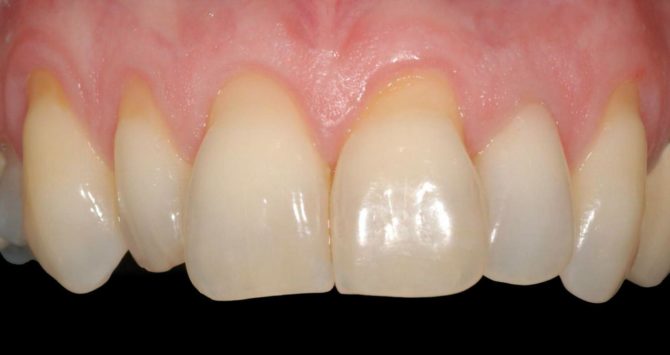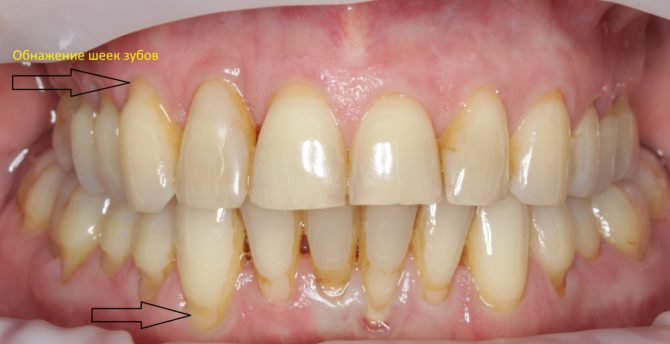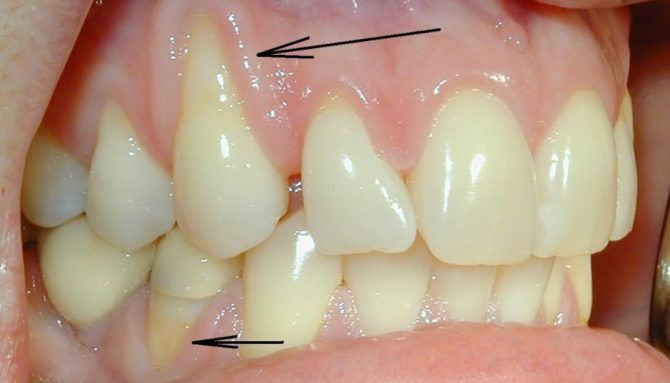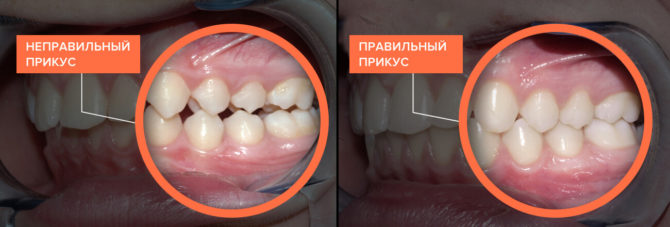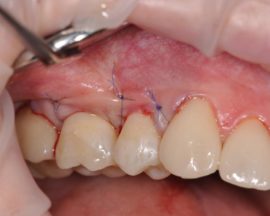Exposure of the neck of the tooth: causes and treatment
Any pathology in the oral cavity requires the closest attention, since advanced diseases of the teeth, gums and other structures of the oral cavity can lead to dangerous complications. Is no exception and gum recession or, more simply, exposure of the tooth neck - we will understand the reasons and get acquainted with the methods of treatment of this pathology.
Content
Symptoms of the disease
Normally, the tooth is surrounded by round, even ridges of gums that hide its neck and upper root. During gum recession, a decrease in the mass of soft tissues near the tooth base occurs, as a result of which the neck of the tooth is exposed up to the roots.
Patients express a variety of complaints with this disease:
- Excessive susceptibility of tooth enamel, which is especially clearly felt when eating chilled or hot food. In severe cases, discomfort occurs even when you open your mouth in a cold room.
- Bleeding. Blood appears even with a slight pressure on the gums when brushing or biting something hard - fruits or bread.
- Swelling of the gums. Due to concomitant inflammation, gingivitis often develops.
- The roots of the teeth are exposed, which makes the risk of caries increased.
- Enamel fragility. Chips and cracks very often occur on the tooth surface.
Why the neck of the tooth is exposed, reasons
There are many reasons for exposing a tooth root, since this pathology in the overwhelming majority of cases is one of the symptoms of some other disease. All the circumstances due to which the gums expose the teeth can be divided into several groups.
Improper hygiene
If during the hygienic procedure to exert excessive efforts and press with bristles not across the tooth surface, but at an angle towards the gum, damage to the cortical plate may occur. As a result, its thinning occurs, the blood supply to the gums deteriorates, their volume decreases - the gums seem to recede from the tooth.
Malocclusion
Due to the violation of the distribution of chewing load, some teeth do not experience chewing pressure. This negatively affects the periodontium, which begins to degrade. People with crowded teeth, with a shallow vestibule of the mouth, with a highly fixed frenulum more often than others complain that their tooth root has been exposed.
Inflammatory and degenerative periodontal lesions
The most common diseases of this group are periodontitis and periodontal disease. Violation of the supply of nutrients to the tooth due to inflammation or improper treatment can lead to a change in the level of gums and exposure of the cervical part of the tooth.
Iatrogenic causes
Exposure of the tooth root can occur due to some medical manipulations:
- intraligamentary anesthesia;
- violations of the preparation of the tooth;
- accelerated orthodontic treatment;
- the use of fixed prostheses and crowns.
Tartar
Subgingival pathological deposits lead to the fact that the gums exfoliate from the tooth neck and root, exposing them. After this, the nutrition of the gingival mucosa worsens and its involution occurs - a decrease.
Diagnostic measures
Treatment of exposed roots of the teeth is carried out only after a thorough diagnosis - it is necessary to find out the cause of the recession of the mucosa. Diagnostic measures include an examination by the dentist and a series of instrumental studies. During the examination, the doctor assesses how bare the teeth of the gums are - the depth and width of the recession are fixed.
An x-ray of the jaw is necessary in order to assess the height of the interdental septum, the degree of destruction of the cortical plates. In certain situations, the structural change is so neglected, which makes it difficult to treat exposure of the roots of the teeth.
It is necessary to evaluate the bleeding index, since if the neck of the tooth is exposed with increased bleeding, it is necessary to treat a disorder in the coagulation system, and only then a recession.
Examination and x-ray picture allow you to set the class of recession:
- First grade. Recession is manifested only by insufficient volume of the gums.
- Second class. A moderate displacement of the gums by 2–4 mm towards the root is noted, the interdental septa have a normal structure, near them a blanching of the mucous membrane is noted.
- Third class. The neck of the tooth is completely exposed, which makes the roots visible.
- Fourth grade. Around the tooth, not only the soft tissue of the gums decreases, but also the bone tissue. There is a pronounced dystrophy of the interdental spaces.
Treatment of exposure of the neck of the tooth in the gums
In the treatment of a bare neck of a tooth, both therapeutic methods and a surgical approach are used. The problem of omission of the gingival mucosa in grades 1 or 2 of the recession is solved by simply teaching a person how to clean his mouth. If the neck of the tooth with an artificial crown is exposed, the treatment consists in re-prosthetics - in 80% of cases this helps to solve the problem.
In symptomatic recession, the underlying disease is primarily treated - anti-inflammatory therapy is performed. Reducing inflammation allows the descended mucosa to recover faster and accelerate growth. Closure of the exposed neck and roots is realized due to the regenerative ability of tissues.
Surgery
With grade 3 or 4 recession with severe gingival descent, only surgical treatment is effective. A therapeutic operation is performed to close the root structures with a gingival flap or an autograft from the sky. The flap is placed in the area of the defect, reducing its area, and is sutured to the surrounding tissues.
With mild prolapse, treatment of exposure of the neck of the tooth with folk remedies is possible, but only after consulting a doctor.
Treatment of exposure of the neck of the tooth with folk remedies
At home, using only folk remedies, it is impossible to cure the exposure of the tooth root. You can only help the gum recover and close the naked neck. To do this, it is recommended to use the following folk recipes:
- Gum massage. The procedure activates blood circulation near the roots, due to which tissue nutrition is improved, and their healing is accelerated. You can increase the effectiveness of the method by using vegetable oil of eucalyptus, peppermint.
- Rinse with a decoction of St. John's wort. The procedure is carried out several times a day and always after a meal. You can make a decoction at home according to the following scheme: 2-3 tablespoons of dry grass are poured with boiled water (300 ml), after cooling, the mixture is defended and filtered - the decoction is ready for use.
- Compresses from herbs with antiseptic activity: chamomile, calendula, sage. To treat a recession at home, using herbal compresses, follows the following scheme: the mixture of herbs is poured with boiling water, then it cools, the resulting wet herbal mixture is wrapped in gauze. Compress is applied to the place of exposure of the roots - this helps to reduce inflammation.
- Some patients who have a tooth neck exposed have a positive effect on chewing psyllium.The leaves of this plant are pre-washed and soaked in cold water for 2-3 hours. Then the sheet is cut into small pieces that need to be chewed. This method can be applied once every two days.
At home, gum recession is treated for a long time. In case of inefficiency or the development of any complications, it is recommended to consult a dentist immediately.
Preventive actions
If the gums sink and expose the tooth roots, preventive measures should be started as early as possible. Their essence lies in scrupulous observance of the rules of oral hygiene. You should learn how to properly operate a toothbrush without injuring soft tissues. Regular disposal of tartar is recommended.
With gingival recession, the prognosis for recovery is relatively favorable - with the elimination of the primary cause, 95% of patients recover. The remaining 5%, even when using surgical treatment, have relapses, so the treatment regimen must be changed.
The most favorable in terms of prognosis is the omission of the gums of the 1st and 2nd classes, since recovery can be achieved without surgery, it is almost impossible to close the defect without surgical treatment at the 3rd and 4th grade.

